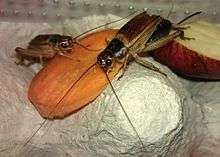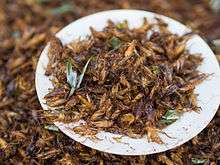House cricket
| House cricket | |
|---|---|
 | |
| Scientific classification | |
| Kingdom: | Animalia |
| Phylum: | Arthropoda |
| Class: | Insecta |
| Order: | Orthoptera |
| Suborder: | Ensifera |
| Family: | Gryllidae |
| Subfamily: | Gryllinae |
| Genus: | Acheta |
| Species: | A. domestica |
| Binomial name | |
| Acheta domestica (Linnaeus, 1758) [1] | |
Acheta domestica, commonly called the house cricket, is a cricket most likely native to Southwestern Asia, but has spread worldwide.[2] They are commercially bred as food for pets such as amphibians, arthropods, birds, and reptiles,[3] but can be kept as pets themselves, as has been the case in China and Japan.[4]
Description
The house cricket is typically gray or brownish in color, growing to 16–21 millimetres (0.63–0.83 in) in length. Males and females look similar, but females will have an ovipositor emerging from the rear, around 12 millimetres (0.47 in) long. The ovipositor is brown-black, and is surrounded by two appendages. On females, the cerci are also more prominent.[5]

Life cycle
House crickets take two to three months to complete their life cycle at 26 to 32 °C (79 to 90 °F). They have no special overwintering stage, but can survive cold weather in and around buildings, and in dumps where heat from fermentation may sustain them. Eggs are deposited in whatever damp substrate is available. Juveniles resemble the adults except for being smaller and wingless.[2]
Human consumption
House crickets are also farmed in Thailand for human consumption, where they have proven to be more popular than the native cricket species due to their superior taste and texture. They are most commonly eaten as a deep-fried snack [6] and are also sold as a protein powder or protein extract.[7] [8]
References
| Wikispecies has information related to: Acheta domesticus |
- ↑ Acheta domesticus at the Encyclopedia of Life
- 1 2 Walker TJ. (2007). "House cricket, Acheta domesticus". Featured Creatures. University of Florida/IFAS.
- ↑ Galloway, Vickie (January 1998). "Raising Crickets". Scarabogram. Scarabs: The Bug Society (213): 2–3.
- ↑ Kulzer, Louise (March 1998). "House Crickets". Scarabogram. Scarabs: The Bug Society (215): 2–4.
- ↑ "Breeding Crickets". Herp Center. Retrieved 2010-07-08.
- ↑ http://www.fao.org/docrep/017/i3246e/i3246e.pdf
- ↑ http://fortune.com/2014/07/18/bugs-in-your-protein-bar-are-edible-insects-the-next-food-craze/
- ↑ http://insecta.maryno.net/?page_id=406
![]() Media related to House cricket at Wikimedia Commons
Media related to House cricket at Wikimedia Commons
